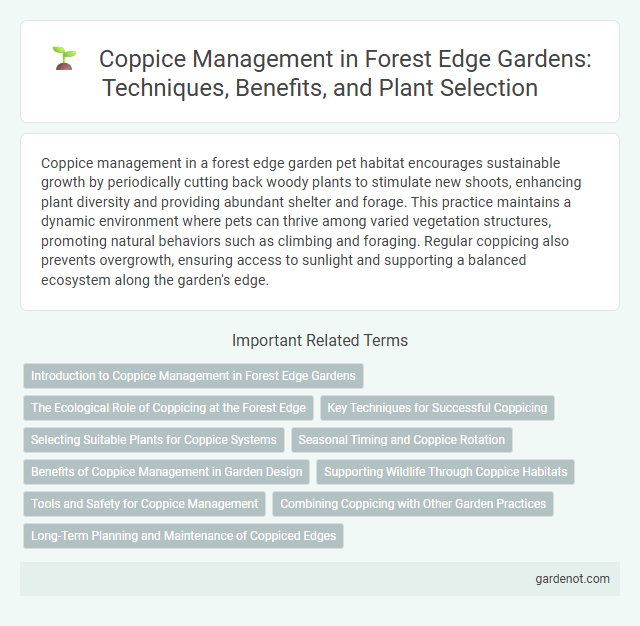Coppice management in a forest edge garden pet habitat encourages sustainable growth by periodically cutting back woody plants to stimulate new shoots, enhancing plant diversity and providing abundant shelter and forage. This practice maintains a dynamic environment where pets can thrive among varied vegetation structures, promoting natural behaviors such as climbing and foraging. Regular coppicing also prevents overgrowth, ensuring access to sunlight and supporting a balanced ecosystem along the garden's edge.
Introduction to Coppice Management in Forest Edge Gardens
Coppice management in forest edge gardens involves the systematic cutting back of trees and shrubs to ground level to promote vigorous regrowth and sustainable wood production. This traditional silvicultural technique enhances biodiversity by creating a variety of habitats and supports soil health through improved light penetration and nutrient cycling. Implementing coppice cycles tailored to species like hazel, willow, and chestnut optimizes ecological benefits and resource yield in forest edge ecosystems.
The Ecological Role of Coppicing at the Forest Edge
Coppice management at the forest edge enhances biodiversity by creating a mosaic of habitats through periodic cutting and regrowth, supporting diverse flora and fauna. This practice maintains structural heterogeneity, allowing sunlight to reach the ground layer, which promotes understorey vegetation and benefits pollinators and ground-nesting birds. The dynamic nature of coppicing also aids in nutrient cycling and soil stabilization, contributing to overall ecosystem resilience.
Key Techniques for Successful Coppicing
Coppice management relies on key techniques such as selecting appropriate tree species like hazel, willow, or sweet chestnut, and timing the cuttings during dormancy in late winter to promote vigorous regrowth. Ensuring regular rotation cycles between 7 to 20 years helps maintain sustainable harvesting while preserving biodiversity and soil health. Proper monitoring of stool health and prompt removal of poor regrowth enhances the longevity and productivity of the forest edge garden.
Selecting Suitable Plants for Coppice Systems
Selecting suitable plants for coppice systems is essential for sustainable forest edge gardens, emphasizing species like hazel, willow, and sweet chestnut known for their vigorous regrowth after cutting. These plants thrive in coppice management due to their ability to produce multiple stems from a single stool, optimizing biomass yield and ecological benefits. Incorporating native, fast-growing deciduous species ensures improved soil health, enhanced biodiversity, and consistent material supply for traditional uses such as fencing, fuel, and crafts.
Seasonal Timing and Coppice Rotation
Coppice management in a forest edge garden requires precise seasonal timing to promote vigorous regrowth and maintain biodiversity. Optimal coppice rotation periods typically range from 7 to 20 years, depending on the tree species and desired wood products. Strategic cutting during late winter to early spring minimizes sap loss and encourages healthy sprout development, sustaining the garden's ecological balance.
Benefits of Coppice Management in Garden Design
Coppice management enhances forest edge gardens by promoting biodiversity through the regular cutting and regrowth of trees, which creates diverse habitats for wildlife. This technique encourages vigorous tree growth, improves soil health by recycling nutrients, and maintains aesthetically pleasing structural variety in garden design. Incorporating coppice management supports sustainable timber and biomass production while fostering seasonal interest and dynamic visual appeal.
Supporting Wildlife Through Coppice Habitats
Coppice management in forest edge gardens creates diverse habitats by fostering varied light conditions and structural complexity ideal for wildlife. Regular cutting cycles promote regrowth that supports a range of species, including birds, insects, and small mammals seeking shelter and foraging opportunities. This sustainable practice enhances biodiversity by maintaining a mosaic of young shoots and mature stems critical for ecosystem health.
Tools and Safety for Coppice Management
Effective coppice management relies on specialized tools such as sharp billhooks, sturdy loppers, and reliable pruning saws designed for precise cutting of young stems. Ensuring safety requires wearing protective gear including gloves, eye protection, and chainsaw-resistant clothing while maintaining clear workspace and proper tool handling techniques. Regular inspection and maintenance of tools minimize risks and enhance efficiency during forest edge garden coppicing activities.
Combining Coppicing with Other Garden Practices
Coppice management enhances forest edge gardens by integrating selective cutting with practices like mulching and controlled grazing to promote vigorous regrowth and soil fertility. Combining coppicing with pruning and native plant layering fosters biodiversity while maintaining structural complexity. Strategic timing of coppice cycles alongside seasonal planting boosts ecosystem resilience and garden productivity.
Long-Term Planning and Maintenance of Coppiced Edges
Coppice management in forest edge gardens requires a strategic long-term plan to promote sustainable regrowth and habitat diversity. Regular rotation cycles, typically spanning 7 to 20 years depending on tree species like hazel or willow, ensure continuous nutrient recycling and structural variation. Maintenance practices must include periodic cutting, debris removal, and monitoring for pest outbreaks to maximize ecological benefits and timber yield.
Coppice management Infographic

 gardenot.com
gardenot.com